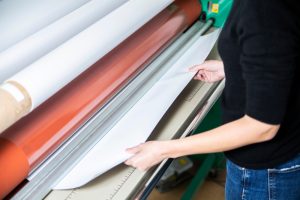Big signs are exciting. They’re eye-catching. They stop people in their tracks. And with the large variety of sign types and designs, the options are virtually endless. How do you pick the right large format materials for your message while ensuring that it will work for your project?
There are two popular materials used as substrates for large format (also called wide format or grand format) printing. While many more are available, these are the go-tos because they work well in many conditions. We’ll cover those in a minute. But first, let’s talk about the category as a whole.
A Brief Review of Large Format Printing
When large-format printing technology hit the scene in the 1950s with vinyl substrate, signs over 24 inches wide could be printed reliably and beautifully, as well as cost-effectively. As the process and materials evolved, so too did the variety. Now, we can print many types of large format signs, including billboards, yard signs, floor graphics, banners, building and vehicle wraps, point of purchase, wall and floor graphics, and much more. In fact the large format printing business is booming, with an expected value of $10.68 billion globally by 2026, up from $8.76 billion in 2020.
Why Choose Large Format Printing?
It’s clear to see that large format is popular. Large format checks a lot of boxes. Do you want impact? Do you want longevity? Do you want to print on demand? Large format signs accomplish all of these:
- Impact: Larger than life messaging practically jumps out at you in a showroom, conference, on the highway, in a store, or out on a sidewalk. Passersby will register the message again and again, and you’ll build brand recognition and attract new customers. Call to actions in large format vehicles are also highly effective. They are also excellent for wayfinding, directing people to your booth or business. Since their print quality has gotten even more precise in recent years, large format signs deliver the wow factor.
- Longevity: Large format signs are built to last. A number of materials can stand up to rough weather and UV rays while maintaining their color fidelity and substrate integrity.
- On Demand: You can print them when you need them. You also don’t need to print large format signs in bulk, so you won’t have to store unused signage or waste it.
Related: “Go Big or Go Home!” Large Format Printing Makes a Big Impact
While there are many excellent substrate choices for these sizes, here are the large format materials you’re most likely to see:
Foam Core (or Foam Board): Lightweight Feel, Heavyweight Impact
Constructed with a foam core of polystyrene and 95%-98% air, foam core signs are very lightweight but still sturdy. You can prop them up on their own, mount them on a wall, frame them, or place them on an easel. Due to their versatility, they’re a favorite for tradeshows, conferences, presentations, and more since they’re easy to transport and their surface is great for high quality printing. They are also quite cost-effective.
How to Use Foam Core
Since the surface is paper, foam core signs are not waterproof or fade-proof—so they’re designed strictly for inside spaces. They must also be handled carefully because they can easily break or dent. You can frame or mount them to increase their longevity. Also note that their acidity makes them inhospitable for any archival materials that you want to maintain as the chemical makeup of the foam core will break it down. Foam core is available in thicknesses ranging from ⅛” or ¼.” Popular sizes are 12” x 18” or 20” x 30” on ⅛.” Sizes can range from as small as 12” x 12” up to 46” x 48.” They’re usually printed on one side in full color.
Coroplast: Quick and Ubiquitous
Coroplast is a fluted, corrugated plastic made with an extruded polypropylene sheet. It is a relatively inexpensive material and is also lightweight and rigid. It’s tougher than a corrugated fiberboard and lighter than an extruded plastic sheet. It’s weather-resistant, stain proof, and waterproof too. A favorite of realtors, political groups, and landscapers, coroplast is easy to mount on signs or fences with grommets, and is often used as yard signs with a frame. You see them everywhere: in yards, on highways, and posted as wayfinding signs for events.
How to Use Coroplast
With coroplast the printing process is quick, flexible, and green since the UV machine can print right on the substrate. It uses LED lights to dry the ink quickly, and this consumes less power than a toaster. Coroplast is available in thicknesses of 4mm to 10mm, and the overall size goes from 16” x 20” up to 48” x 96.” You can find it in black or white or in a range of custom colors.
Related: Amp Up Your Signage Design with 7 Cool Large Format Ideas
Sign Time!
There are even more large format material options to explore, but these two popular substrates are ideal for most applications. Ironmark loves going big. We have a team of large format experts at the ready to help you go big too. And we can help you tie these wow-getters into a larger campaign with multiple digital and print touchpoints too. For over sixty years, we’ve helped our clients make stunning signage, and as the technology has improved, we’ve stayed on the cutting edge.
Have sign questions? Marketing questions? We can show you why signs are such big business—and how to use your signs to boost yours.




